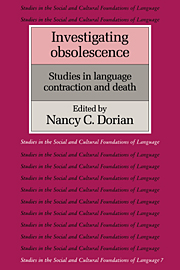Book contents
- Frontmatter
- Contents
- List of maps
- List of contributors
- Preface
- Map
- Dedication
- Introduction
- I Focus on context
- II Focus on structure
- 11 Problems in obsolescence research: The Gros Ventres of Montana
- 12 The structural consequences of language death
- 13 On signs of health and death
- 14 Case usage among the Pennsylvania German sectarians and nonsectarians
- 15 Estonian among immigrants in Sweden
- 16 The incipient obsolescence of polysynthesis: Cayuga in Ontario and Oklahoma
- 17 Urban and non-urban Egyptian Nubian: Is there a reduction in language skill?
- 18 Some lexical and morphological changes in Warlpiri
- 19 Language contraction and linguistic change: The case of Welland French
- 20 Lexical innovation and loss: The use and value of restricted Hungarian
- III Invited commentaries
- Bibliography
- Index of languages
- General index
14 - Case usage among the Pennsylvania German sectarians and nonsectarians
Published online by Cambridge University Press: 08 January 2010
- Frontmatter
- Contents
- List of maps
- List of contributors
- Preface
- Map
- Dedication
- Introduction
- I Focus on context
- II Focus on structure
- 11 Problems in obsolescence research: The Gros Ventres of Montana
- 12 The structural consequences of language death
- 13 On signs of health and death
- 14 Case usage among the Pennsylvania German sectarians and nonsectarians
- 15 Estonian among immigrants in Sweden
- 16 The incipient obsolescence of polysynthesis: Cayuga in Ontario and Oklahoma
- 17 Urban and non-urban Egyptian Nubian: Is there a reduction in language skill?
- 18 Some lexical and morphological changes in Warlpiri
- 19 Language contraction and linguistic change: The case of Welland French
- 20 Lexical innovation and loss: The use and value of restricted Hungarian
- III Invited commentaries
- Bibliography
- Index of languages
- General index
Summary
For immigrant and minority languages in the United States, language death is an almost inevitable outcome of contact with American English. The promise of social and economic advancement proffered by mastery of English eventually overcomes the most fervent of language loyalty intentions. The number of social contexts in which speakers can use the minority language. steadily declines. Without the support of continued immigration from the language homeland, the number of fluent interlocutors gradually decreases, and eventually no social context remains in which it is appropriate to speak the minority language. Pennsylvania German, although it has enjoyed a long history in America, is no exception to this general process.
Pennsylvania Germans settled in America during colonial times in farm communities across southeastern and central Pennsylvania. Secondary settlements arose later in Ohio, Indiana, Illinois, and the Virginias. While many of these communities have long ago completely and irrevocably assimilated into mainstream American society, some have maintained their peculiarly Pennsylvania German (PG) culture and language to the present time. Although all Pennsylvania Germans share many traits and values, the PG population is not one homogeneous group. It consists of many subgroups, each having a different relationship to the dominant society, and each speaking a variety of Pennsylvania German which fulfills different communicative and symbolic functions. The purpose of this study is to document linguistic change in such subgroups: Pennsylvania German, as it is dying in farm communities of nonsectarians, and as it is being maintained in farm communities of Amish and Mennonite sectarians.
Background
Within a community shifting from one language to another, proficiency in the receding language varies widely.
- Type
- Chapter
- Information
- Investigating ObsolescenceStudies in Language Contraction and Death, pp. 211 - 226Publisher: Cambridge University PressPrint publication year: 1989
- 24
- Cited by



